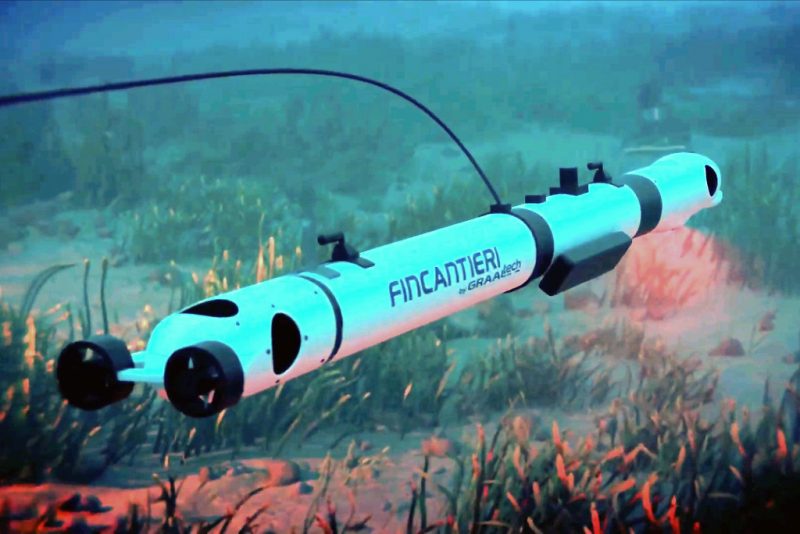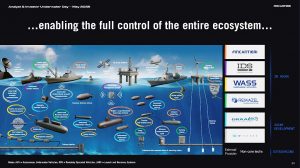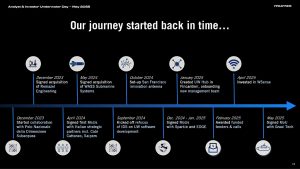Fincantieri aims to become a leading player in the underwater domain
Fincantieri has recently presented to the financial and media communities its long-term strategic vision for the development of its underwater segment. The company outlined a clear, ambitious, and already well-advanced path toward industrial growth in this field. With its strong capability to integrate complex competencies and high-tech industrial assets, Fincantieri aims to position itself as a leading player in this sector. To oversee and guide this transformation, the Italian shipbuilder has established a dedicated Underwater Hub, responsible for coordinating and controlling civil, military and dual-use activities, ensuring market presence and internalization of proprietary high-value technologies. This is the introduction of a series of articles on Fincantieri underwater capabilities that were highlighted during the recent “Underwater Day” for analysts and investors
“Fincantieri is evolving its business mix to support growth and profitability,” CEO Pierroberto Folgiero said, introducing the company’s development strategy in the underwater sector at the recent “Underwater Day” for analysts and investors. He highlighted that the underwater multi-dimensional ecosystem is expected to double its size in the company’s revenues, from 4 to 8%, by 2027, with further upside potentials in the following years, driven by higher margins and stronger cash conversion associated with new underwater technologies and surface ships designed for underwater operations.
Focusing on the naval and underwater business segments, Folgiero said the Group has a high likelihood of gaining approximately € 20 billion in naval opportunities (out of a total market of approximately 30 billion euro) in the 2025-2027 period. In the US, the Italian shipbuilder is targeting defence and commercial projects such as icebreakers, while in South America, it is looking at opportunities related to corvettes and light frigates. In Europe, the focus is on submarines and heavy frigates, while in Africa on light frigates, corvettes and amphibious units. The Middle East offers a balanced mix including also patrol vessels and naval services, while the Asia-Pacific region is primarily driven by the demand for submarines, corvettes and light frigates.
“Fincantieri is able to address the increasing naval demand through its flexible global footprint,” Folgiero continued, citing the role of the Italian hybrid shipyards (e.g. Palermo and Castellammare di Stabia) in doubling naval production capacity, the adaptable production network in Romania and Vietnam to manage extra commercial demand, and the scaling up of US operations to support current and future programmes and new opportunities (e.g. icebreakers and cable layers). Additionally, the company boasts a strong and distinctive ability to localize activities to seize regional opportunities.
In the underwater segment, “Fincantieri is leveraging its unique expertisein conventional technologies (e.g. submarines, effectors, sonars) to broaden its underwater ecosystem”, Folgiero explained. This includes combining conventional products with innovative technologies, expanding applications beyond defense to dual-use and commercial domains and delivering integrated, high-tech solutions to a wide range of clients.”
“Fincantieri has a long-standing history in this industry. We built our first submarine over a century ago and delivered 118 so far. We fully master traditional underwater technologies, such as submarines, effectors, and sonars, but we are now looking ahead to the future of the underwater domain,” Folgiero said. There is a vision according to which the underwater will be – today it still is a blank piece of paper – what the space was 40 years ago. It is estimated that by the next century, 40% of food resources could originate from the seabed. Today, 80% of the seabed and up to 98% of the abyssal regions remains unexplored. With growing global energy needs, offshore renewable energy at sea, or other forms of energy at sea, would be the name of the game. The seabed is already filled with telecom cables, and the protection of these and other submerged critical infrastructures must be addressed urgently.”
Fincantieri as market Orchestrator
“Thanks to its vertically integrated business model, Fincantieri is uniquely positioned to design, build, integrate and operate all key components of a new underwater ecosystem,” Folgiero stated. “This enables the company to lead the transformation and tackle cross-domain challenges by leveraging its history, assets, and forward-looking vision. Fincantieri brings expertise across multiple domains, adopting a holistic approach to innovation. The global underwater market is estimated to be worth approximately € 50 billion annually, with an accessible underwater segment for Fincantieri projected at an average of € 22 billion per year.
“Various development factors are driving the emergence of market leaders, and Fincantieri is taking on the role of orchestrator in this transformation,” he continued. “Our goal is to become a “one-stop shop” for the underwater industry, delivering turnkey, end-to-end solutions, vertically integrating core technologies and leading technical innovation.”
Folgiero emphasized the importance of strengthening conventional platforms such as submarines: “We are mastering new air-independent propulsion systems and developing our own fuel cells in Italy at Isotta Fraschini. We are also investing in new lithium batteries, complete with our proprietary battery management system technology, to optimize energy control on future platforms.”
“Additionally”, he noted, “we are designing solutions to recharge underwater drones once they are ending their mission on the seabed, potentially using energy harvested from underwater telecom cables. We are also rethinking the role of surface ships as motherships for unmanned underwater vehicles in the context of this new ecosystem.”
Systems integration, command and control, and advanced electronics are key enablers in this evolution. “These systems have to be interconnected through cutting-edge technologies. We are already cooperating with WSense, a pioneer in underwater Internet of Things, optical and acoustic telecommunication, and data exchange. This is a clear example of Fincantieri’s vertical integration strategy, and its capacity to operate across the entire value chain – from design to operation – of the underwater ecosystem.”
First operational test of Fincantieri’s underwater infrastructure protection in autumn
“Fincantieri aims to assume a leadership role in the evolving underwater domain, by positioning itself, as mentioned, as a vertically integrated orchestrator of core technologies,” Gabriele Cafaro, Head of Fincantieri’s Underwater Hub, stated. “In a relatively short time, less than two years, the company has prepared the ground for market entry through three key lines of action.”
On the mergers and acquisitions front, Fincantieri acquired Remazel Engineering in late 2023 and signed the agreement to acquire today WASS Submarine Systems in May 2024, with closing in January 2025. “These acquisitions grant our company access to fast-growing markets, new products, and new strategic underwater technologies,” Cafaro said.
Internally, at the beginning of 2025, Fincantieri has set up a new centralized hub to coordination all underwater-related business entities, while also strengthening the leadership team with professionals from the Defence and Oil & Gas sectors.
The third strategic axis focuses on long-term industrial partnerships. “We have signed MoUs with Saipem, Cabi Cattaneo, and Sparkle, as well as with EDGE outside Italy. We actively cooperate with the Polo Nazionale della Dimensione Subacquea (National Underwater Cluster), and we are contributing to the national underwater tenders. Recently we also invested in WSense, a leader in underwater wireless communications.”
On the same day of the Underwater Investor Day, Fincantieri signed an MoU with Graal Tech, a company with strong expertise in small underwater drones. “This agreement includes exclusivity for future developments,” Cafaro explained. “As a result of this strategic journey, Fincantieri now covers the full spectrum of core technologies throughout the entire underwater ecosystem.”
“We are now ranging from surface to seabed,” Cafaro continued. “Surface vessels are evolving into drone carrier motherships, supporting a new generation of underwater vehicles, both traditional and unconventional, and enabling applications such as deep-sea mining, offshore energy and aquaculture. Our solutions also range from hardware to software, including submarine platforms, electro-acoustic components, originally developed by WASS for sonars, now adapted for critical infrastructure protection or underwater communication.”
At the heart of this entire architecture is the underwater management system (UMS) developed by Fincantieri’s company Ingegneria Dei Sistemi (IDS), enabling the Group to deliver end-to-end integrated solution. “The first operational demonstration of these capabilities will be tested this autumn in the Gulf of La Spezia,” Cafaro concluded.
Images and graphics courtesy Fincantieri




